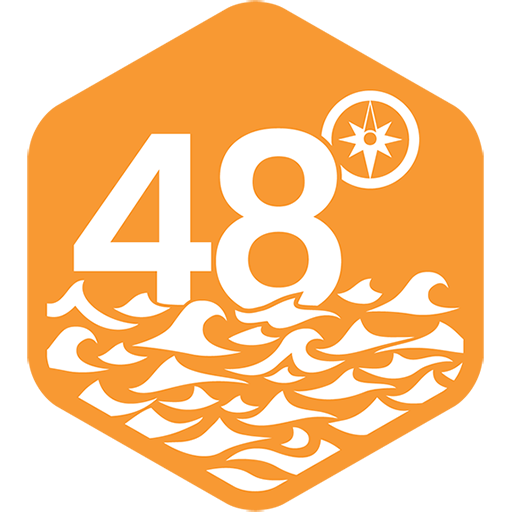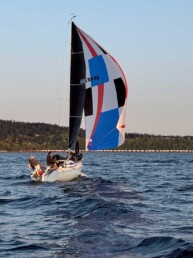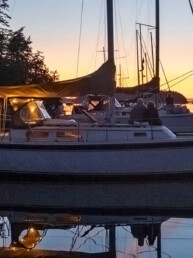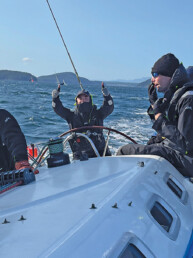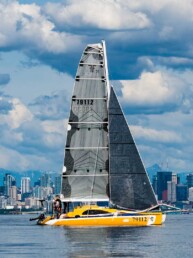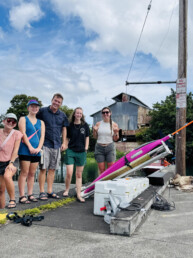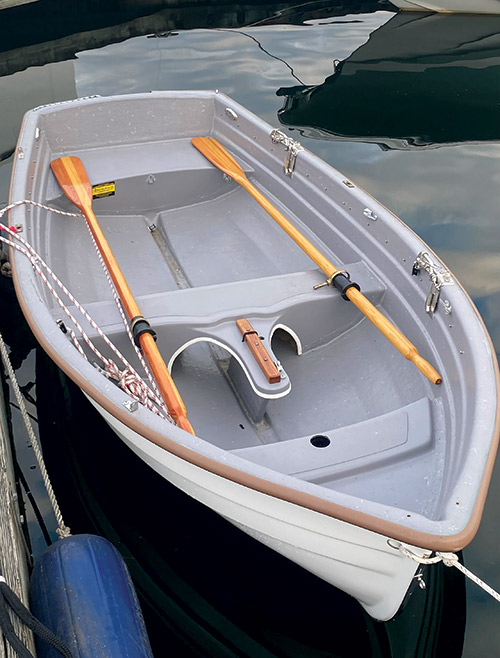
elegantly simple layout.
My phone blurped to life. It was my friend Ed sending a photo of an elegant navy blue powerboat. Ed and I have known each other going on 15 years and have cruised together on a number of occasions. In that time, he owned and really loved several sailboats. Ed was selling his Tartan and trying something new.
Six weeks later and a few days into a trip in the San Juan and Gulf islands together, Ed had heroically rescued our disabled sailboat with a tow, and then generously allowed me to stow away on his new boat so I could continue on our journey while the sailboat was in the yard. But that’s not what this story is about. This story is about the 10-foot tender cleverly tipped up athwartships on his transom.
As nice as Ed’s powerboat was, the little knockabout astern stole my heart. That row/sail dinghy was a Gig Harbor Boat Works Navigator 10, and it’s about to receive the award for the smallest boat I’ve ever reviewed for 48° North. Spoiler: If I had other awards to give out, the Navigator 10 would probably get a few, because this little tender gets some seriously high marks from me for its fun, utility, and versatility.
Design
The Gig Harbor Navigator 10 is not a new design, it’s been around for nearly three decades. But it was new to me, and discovering it was a delight. The Navigator is full of complementary contradictions: it’s wonderfully simple and still feature-packed; it moves remarkably well without sacrificing stability and buoyancy; and its snappy appearance could bely the premium quality and durability that will make it a member of your fleet for years to come.
The Navigator is 10 feet in length, 54 inches on the beam, and the standard version displaces 90 pounds (an “Ultralite Composite” version is available that weighs only 75 pounds). Gig Harbor and Navigator owners say the boat is light enough to put atop a car. The sailing rig comes standard with a 45 square foot mainsail, and a “High Performance” option adds a removable bowsprit and a genoa increasing the sail area by 28 square feet. Further customizations abound depending on how a person would like to use or mount the boat. Ed’s Navigator had the High Performance sailing rig and the standard composite layup.
The first thing I noticed was this was a boat, not a RIB-like hog with initial stability for days—you’re not stepping on the gunwale while getting in and out, but that’s typical of a dinghy of this style. Part of the Navigator’s handsome look is the gentle curve of its soft chines and, while its hull form provides stability, the design is made to offer more than just stability, and it may feel tippy to some at first. Gig Harbor makes another similarly sized tender with more initial stability, but it comes with different compromises and wouldn’t row or sail as well as the Navigator. If you’re mindful of your weight placement, moving in, out, and around the boat becomes second-nature; and once seated and settled, I had zero doubts that the Navigator would stay upright, including in some chop. Buoyancy compartments fore and aft provide a bit of safety net should you swamp it, but I’m not sure if you could right it, bail it, and sail it away again.
These attributes are just thoughtful design decisions that differentiate this dinghy from some of the burlier ones I’ve used—as I always seem to write in these tests, all boat design is an exercise in compromise.
One useful note is that Ed’s Navigator was affixed to his powerboat with the Weaver Davits system (a stout but minimalist hinging davit option that you can purchase through Gig Harbor). When the dink is in the water for ship-to-shore purposes, these davits lock one side of the Navigator to the mothership, allowing for less attentive entry, exit, loading and unloading, and setting up the sail rig. If that system works on your boat, I’d recommend it.
Rowing
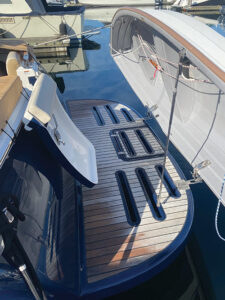
I suspect most Navigator 10 owners row their boats more than they sail or motor. Any cruiser knows the value of a reliable ship-to-shore tender. Moreover, anyone who has rowed an inflatable knows the compromises and effort that come along with it. Though you can mount a motor to the Navigator 10, it shines as a rowboat. It wowed me with its rowing manners, enough to make an outboard seem inconvenient and unnecessary for most applications.
I rowed it alone and with Ed (together, we added about 400 pounds to the boat), and in each case it was very quick. It just seemed to hardly touch the water and made no wake at all. This is where you start to see the benefits to a dinghy with a more balanced design, one that doesn’t sell the farm for initial stability. It was a comfortable, efficient, fast rowing experience—what more could you ask for?
Gig Harbor promotes the importance of the full-length keels on their tenders and, indeed, I thought the Navigator tracked extremely well.
My only complaint when rowing was that the Navigator was almost too slippery in tight quarters, which I discovered when running a stern line to shore at Wallace Island’s Princess Cove. I had to make a conscious effort to slow it down near the barnacle-covered rocks—though I didn’t want to damage it, it was reassuring that it wasn’t at risk of popping and deflating if I miscalculated and had a little scrape.
As much as I enjoyed sailing the Navigator 10—and I did, and I’ll get to that shortly—to me, it is a brilliant boat to row. Full stop.
Sailing
A good tender’s utility notwithstanding, if it also provides the opportunity for a little extra fun… Yahtzee! Adding the sailing rig to the Navigator 10 does that in spades. It’s a critical element of Ed’s decision to select this dinghy as a sailor who now owns and cruises a powerboat. In his own words, “It scratches the itch.”
The sailing set-up on the Navigator 10 takes multiple forms. It can be sailed with main alone, which is quite easy to rig and still sails well and provides a lot of fun. But turning it into a sloop rig with the High Performance addition of the bowsprit and genoa make it a really well-rounded and impressive little sailboat. A simple daggerboard and flip-up rudder complete the kit.
The navigator’s two-piece mast is aluminum and it slips into the step hole that’s well forward, but not all the way to a cat-rigged position in the bow. The forward mast location allows for reasonably good performance under main alone. Spectra shrouds support the mast. The main is attached to the mast with plastic collars and at the clew with a slide-in slug. The rig and main make a genuinely nice shape, though it is definitely possible to overtrim.
The bowsprit joins the boat with through-bolts and wingnuts, nesting under the bow’s rub rail. The forestay is integral to the genoa, so adding and rigging it is quick. Sheets run outside the shrouds to fixed lead blocks and then through jam cleats. The bowsprit moves the headsail position forward enough to allow essential airflow through the slot between the two sails.
The days we sailed the Navigator, it was typical summer conditions in the islands—light wind, in other words. It was a soft landing to figure out the boat, though I quickly found it wasn’t enough to offset much of my 220 pounds in a 10-foot dinghy. Ed preferred to sit in the sole of the Navigator, but I started out kneeling on a foam life jacket. That worked better for weight responsiveness but eventually got tiring, and I think sitting is most likely to be the best choice. That said, tacking with the behind-the-back tiller transfer took me back to dinghy racing days and provided a little extra thrill!
From our location at the head of the cove, we had to start off reaching downwind, and then work back upwind. With both main alone and sloop set-ups, we had no trouble—meaning the boat’s upwind performance is more than adequate. Of course, in the light air, that’s also where it was most rewarding to “feel” the boat.
Even in light puffs the Navigator really had some notable get-up-and-go. Mimicking hiking, I could lean into the windward side during a puff and feel the boat scoot ahead. I’d imagine that even moderate breeze, say 8 knots, would move the Navigator into really engaging sailing dynamics, and that by 13 knots you’re into the realm of proper excitement.
Though in the age of tiny-boat cruises and adventure races I wouldn’t say camp cruising in the Navigator is out of the question, the sailing set-up is most likely to be used for a joyful little jaunt from your cruising boat in a picturesque Pacific Northwest harbor, or just dropping the boat into the water for a dedicated day sail. And in those applications, it really does perform beautifully.
The Gig Harbor Navigator 10 might be the best do-it-all tender available, and some will love it as a stand-alone boat to take out just for the fun of it. Among the dinghies I’ve used, it would be my choice. A rock-solid RIB with an outboard appeals in a different way, but the Navigator offers so much more and does it all very, very well.
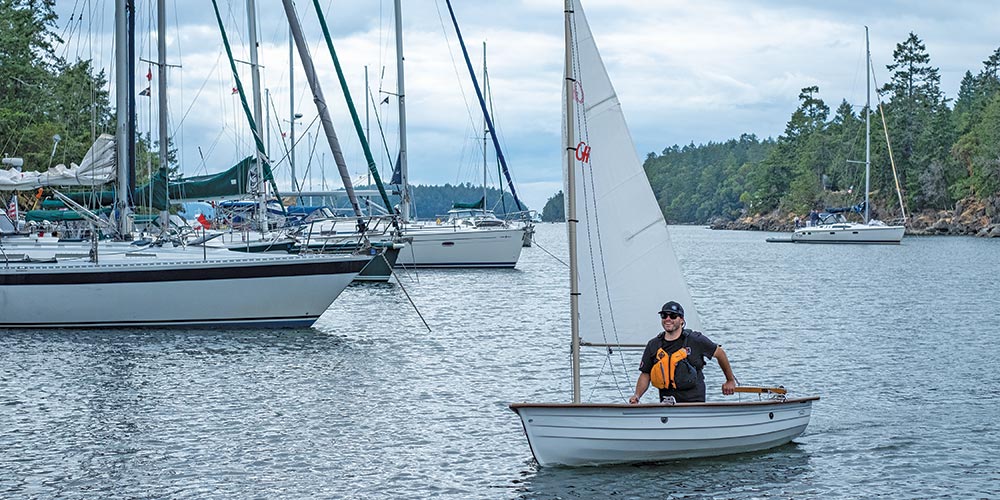
Joe Cline has been the Managing Editor of 48° North since 2014.
Joe Cline
Joe Cline has been the Managing Editor of 48° North since 2014. From his career to his volunteer leadership in the marine industry, from racing sailboats large and small to his discovery of Pacific Northwest cruising —Joe is as sail-smitten as they come. Joe and his wife, Kaylin, have welcomed a couple of beautiful kiddos in the last few years, and he is enjoying fatherhood while still finding time to make a little music and even occasionally go sailing.
